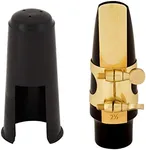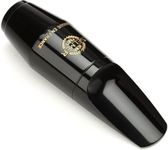Buying Guide for the Best Alto Saxophone Mouthpieces
Choosing the right alto saxophone mouthpiece is crucial for achieving the best sound and playability. The mouthpiece is a key component that affects the tone, response, and overall performance of your saxophone. When selecting a mouthpiece, consider your skill level, the type of music you play, and your personal preferences. Understanding the key specifications will help you make an informed decision and find the best fit for your needs.MaterialMouthpieces are typically made from hard rubber, metal, or plastic. The material affects the sound and feel of the mouthpiece. Hard rubber mouthpieces are known for their warm, rich tone and are popular among classical and jazz players. Metal mouthpieces produce a brighter, more powerful sound, making them suitable for rock, pop, and contemporary jazz. Plastic mouthpieces are often used by beginners due to their affordability and durability. Choose a material that complements your playing style and the genre of music you play.
Tip OpeningThe tip opening is the distance between the tip of the reed and the tip of the mouthpiece. It influences the ease of play and the sound produced. Smaller tip openings (close) require less air and are easier to control, making them ideal for beginners and classical players. Larger tip openings (open) require more air and offer greater flexibility and volume, preferred by jazz and contemporary players. Consider your experience level and the type of music you play when selecting the tip opening.
Facing LengthThe facing length is the distance from the tip of the mouthpiece to the point where the reed and mouthpiece meet. It affects the response and flexibility of the mouthpiece. Shorter facings provide a quicker response and are easier to play, suitable for beginners and those who play fast passages. Longer facings offer more flexibility and a fuller sound, preferred by advanced players and those who play expressive, lyrical music. Choose a facing length that matches your playing style and skill level.
Chamber SizeThe chamber is the internal space of the mouthpiece and comes in different sizes: small, medium, and large. The chamber size affects the tone and projection of the sound. Small chambers produce a brighter, more focused sound, suitable for contemporary and pop music. Medium chambers offer a balanced tone, making them versatile for various music styles. Large chambers produce a darker, richer sound, ideal for classical and traditional jazz. Select a chamber size that aligns with the sound you want to achieve and the genre you play.
BaffleThe baffle is the part of the mouthpiece that directs the airflow and affects the brightness and projection of the sound. High baffles create a brighter, more powerful sound with increased projection, suitable for rock, pop, and contemporary jazz. Low baffles produce a warmer, mellower sound with less projection, preferred by classical and traditional jazz players. Consider the type of music you play and the sound you want to achieve when choosing the baffle design.
























